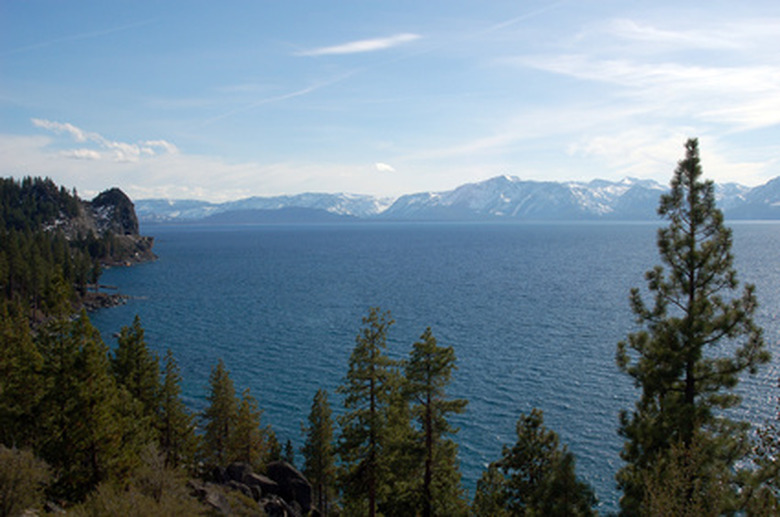Types Of Evergreen Trees In Tahoe
The Tahoe region of California and Nevada includes the Tahoe National Forest and Lake Tahoe Basin. The forest extends east from Sacramento and the Sierra Nevada foothills across the mountains to the California/Nevada border. The Lake Tahoe Basin straddles the border. This mix of private and public lands is a place of forested slopes, streams, lakes and rivers where several species of majestic evergreen trees reign.
White Fir
Several species of white fir (Abies concolor) are common throughout the western mountain ranges of the United States. They can grow anywhere from 50 to 150 feet tall at up to 60 feet wide. Cone-shaped young trees become less symmetrical as they mature. Trees that grow closely together develop branches halfway up or more of their trunks. The branches of solitary trees begin at ground level. Silver-barked white fir's greenish-blue needles become whiter as they age. The green to purple cylindrical cones are up to 5 1/2 inches long. Rodents and songbirds feed on the seeds, while deer browse on the needles.
- The Tahoe region of California and Nevada includes the Tahoe National Forest and Lake Tahoe Basin.
- Silver-barked white fir's greenish-blue needles become whiter as they age.
The Tahoe area is home to the California white fir. This popular ornamental, shade and Christmas tree grows slowly, adding between 1 and 1 1/2 feet per year. It likes sun to part shade and well-drained, sandy loam or gravel soils, and suffers in heavy clay.
Ponderosa Pine
Wild Ponderosa pines (Pinus ponderosa) can grow to more than 250 feet tall. Cultivated trees, however, generally reach between 60 and 150 feet, states the Lady Bird Johnson Wildflower Center. The trees' short, heavy branches begin halfway up the trunks on mature trees. Orange-yellow or cinnamon-colored bark contrasts with the trees' yellowish-green or grayish-green, tufted needles. The Tahoe areas' Pacific Ponderosa pine has three needles in each tuft. Its seeds are a source of food for birds, squirrels and several other wildlife species. Trees tolerate full sun and shade and dry or moist locations. They prefer deep, loamy, sand, gravel or clay soils on the acidic side (pH below 7.0).
- The Tahoe area is home to the California white fir.
- The Tahoe areas' Pacific Ponderosa pine has three needles in each tuft.
Jeffrey Pine
Jeffrey pine (Pinus jeffreyi), the smallest of the Tahoe' s pines, stands between 40 and 90 feet high. Like the Ponderosa pine, it has orange- to cinnamon-colored, peeling bark. Its crushed bark and twigs emit a fragrance that's been compared to those of lemons, vanilla, violets or pineapples. Mature trees' spreading branches appear more than halfway up their straight trunks. This pine, says the Lady Bird Johnson Wildflower Center, has cones between 6 and 9 inches long. Its greenish-blue needles can also reach 9 inches. Jeffrey pine occurs and elevations between 6000 and 9000 feet. It grows in dry, rocky, well-drained soil and part shade, and requires planting among other pine or oak trees.
- Jeffrey pine (Pinus jeffreyi), the smallest of the Tahoe' s pines, stands between 40 and 90 feet high.
- Like the Ponderosa pine, it has orange- to cinnamon-colored, peeling bark.
